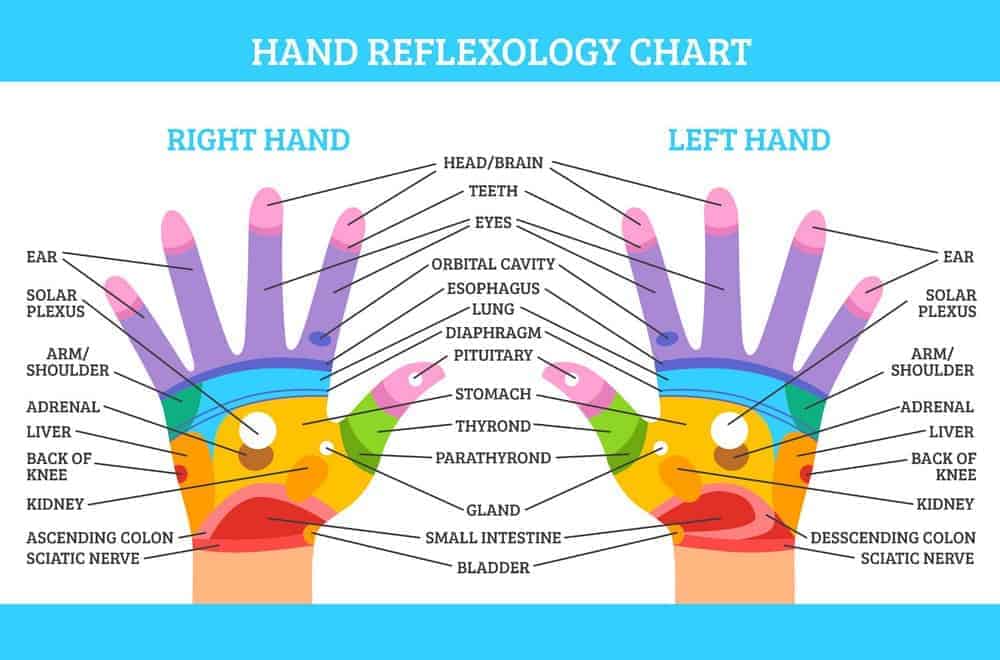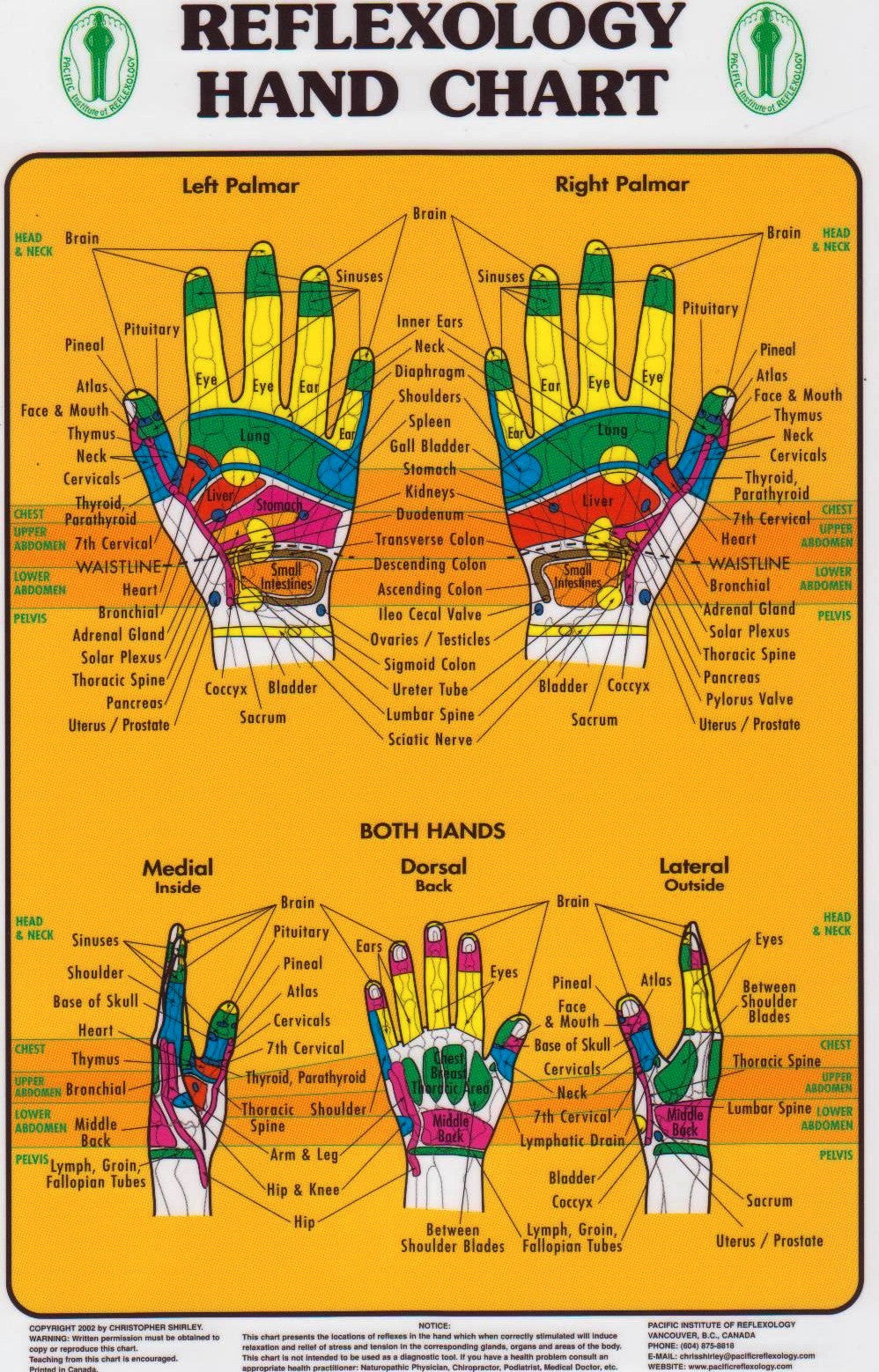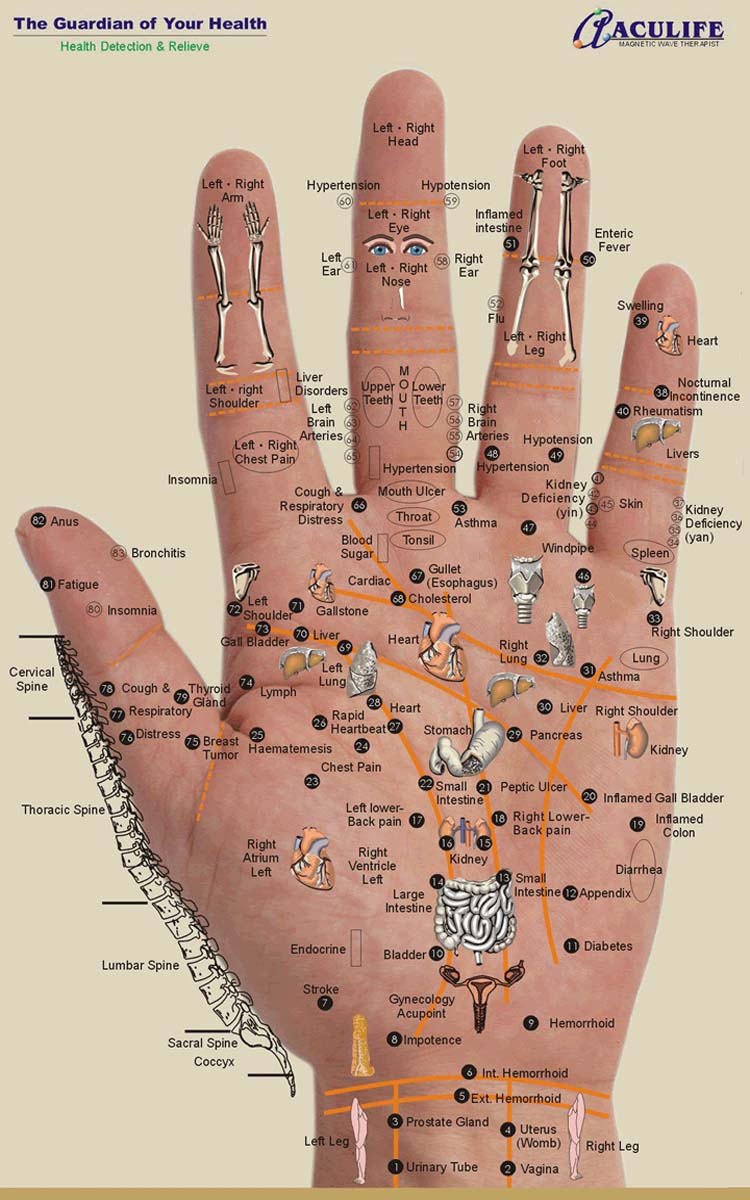Hand reflexology is a fascinating practice that has been used for centuries to promote relaxation, enhance well-being, and improve overall health. By applying pressure to specific points on the hands, you can stimulate various organs and systems in the body, relieving pain and restoring balance. Today, we will explore the principles of hand reflexology and highlight some essential pressure points that you can start incorporating into your self-care routine.
Hand Reflexology Chart #1
 This first hand reflexology chart provides a clear visual representation of the different pressure points on the hand and their corresponding organs. As you can see, the hand is divided into zones, with each zone directly linked to specific areas of the body. For example, the thumb corresponds to the head and neck, while the pinky finger is associated with the shoulder and arm.
This first hand reflexology chart provides a clear visual representation of the different pressure points on the hand and their corresponding organs. As you can see, the hand is divided into zones, with each zone directly linked to specific areas of the body. For example, the thumb corresponds to the head and neck, while the pinky finger is associated with the shoulder and arm.
Hand Reflexology Chart #2
 Here is another hand reflexology chart that focuses on seven crucial pressure points on the hand. These points are believed to have a significant impact on our health and well-being. By applying gentle pressure to these areas, you can potentially alleviate discomfort and promote relaxation. So, let’s explore these essential pressure points:
Here is another hand reflexology chart that focuses on seven crucial pressure points on the hand. These points are believed to have a significant impact on our health and well-being. By applying gentle pressure to these areas, you can potentially alleviate discomfort and promote relaxation. So, let’s explore these essential pressure points:
Thumb Point
 The thumb point, found at the base of the thumb, is connected to the head and neck region. Applying pressure to this point may help relieve headaches, migraines, and tension in the neck muscles.
The thumb point, found at the base of the thumb, is connected to the head and neck region. Applying pressure to this point may help relieve headaches, migraines, and tension in the neck muscles.
Index Finger Point
 The pressure point on the index finger is associated with the sinus area. Gently massaging this point may help alleviate congestion and provide relief from sinus-related symptoms.
The pressure point on the index finger is associated with the sinus area. Gently massaging this point may help alleviate congestion and provide relief from sinus-related symptoms.
Middle Finger Point
 The middle finger point corresponds to the eye area. Applying pressure to this point can help reduce eye strain, eye fatigue, and even improve vision.
The middle finger point corresponds to the eye area. Applying pressure to this point can help reduce eye strain, eye fatigue, and even improve vision.
Ring Finger Point
![]() The pressure point on the ring finger is connected to the ear. Massaging this point may help alleviate earaches, ringing in the ears, and other ear-related discomfort.
The pressure point on the ring finger is connected to the ear. Massaging this point may help alleviate earaches, ringing in the ears, and other ear-related discomfort.
Pinky Finger Point
 The pinky finger point is associated with the throat and vocal cords. Applying pressure to this point may help soothe a sore throat, promote clear communication, and enhance self-expression.
The pinky finger point is associated with the throat and vocal cords. Applying pressure to this point may help soothe a sore throat, promote clear communication, and enhance self-expression.
Wrist Point
 The final essential pressure point is located on the wrist. By applying gentle pressure to this area, which is linked to the head and sinuses, you may find relief from headaches, sinus pressure, and tension in the forehead.
The final essential pressure point is located on the wrist. By applying gentle pressure to this area, which is linked to the head and sinuses, you may find relief from headaches, sinus pressure, and tension in the forehead.
Hand reflexology, when incorporated into your daily routine, can provide immense benefits for your overall well-being. Whether you are seeking relaxation, pain relief, or an improved sense of balance, exploring the pressure points on your hands is an excellent place to start. Remember to breathe deeply and apply gentle, consistent pressure to each point. By doing so, you can take an active role in supporting your health and wellness.
Hand Reflexology Chart #3
 To further deepen your understanding of hand reflexology, take a look at this comprehensive hand reflexology chart. It provides a detailed map of the hand, highlighting the various pressure points and their corresponding organs and body parts. By referring to this chart, you can tailor your self-care routine to target specific concerns or areas of discomfort.
To further deepen your understanding of hand reflexology, take a look at this comprehensive hand reflexology chart. It provides a detailed map of the hand, highlighting the various pressure points and their corresponding organs and body parts. By referring to this chart, you can tailor your self-care routine to target specific concerns or areas of discomfort.
As you can see, hand reflexology is a simple yet powerful practice that anyone can incorporate into their daily routine. By taking just a few minutes each day to apply gentle pressure to these pressure points, you can unlock the potential for profound relaxation, pain relief, and overall well-being. So, why not give hand reflexology a try today?
Hand Reflexology Chart #4
 This final hand reflexology chart, created by the International Institute of Reflexology, offers a comprehensive view of the hand and its reflexology zones. By exploring this chart, you can gain a deeper understanding of the interconnectedness of the body and the potential impact of hand reflexology on your overall health and well-being.
This final hand reflexology chart, created by the International Institute of Reflexology, offers a comprehensive view of the hand and its reflexology zones. By exploring this chart, you can gain a deeper understanding of the interconnectedness of the body and the potential impact of hand reflexology on your overall health and well-being.